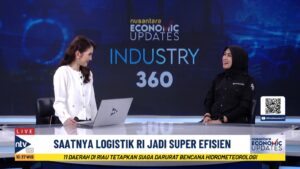Increased Supply Chain Efficiency with AR and VR in 2024
Posted on August 22, 2024 by Nur Wachda Mihmidati

By 2024, the Augmented Reality (AR) and Virtual Reality (VR) market in Indonesia is expected to generate US$397.7 million in revenue, with projected annual growth of 9.78% to reach US$634.2 million by 2029. The dominance of AR software, which generated US$123.8 million in 2024, shows great potential in applications for supply chain management. AR technology can simplify training, maintenance, and inventory management, while VR offers simulation and design that helps in supply chain optimization.
The number of AR & VR users in Indonesia is expected to reach 145.0 million by 2029, with the penetration rate increasing from 47.0% in 2024 to 50.0% in 2029. While the data only covers B2C revenue, AR & VR technology also has great potential in the B2B sector, including applications in the supply chain. With a projected ARPU of US$3.0, adoption of these technologies can accelerate digital transformation in supply chain management, offering significant innovation and efficiency in enterprise operations.

Use of AR and VR in Supply Chain Processes
Several uses of AR and VR have been applied to the supply chain process. One of them is applied to DHL for the order selection process or Amazon for monitoring their products.
AR for Order Selection Process
In 2020, logistics provider DHL found that around 20% of their total logistics costs came from packaging, storage and form management activities. Recognizing the high cost and time spent in this process, DHL decided to look for solutions to improve efficiency in their warehouses, specifically when it comes to the selection and packaging of goods.
As part of this initiative, DHL decided to test VR and AR wearable technology in one of their warehouses in the Netherlands. By using smart glasses and other AR technologies, they were able to increase the efficiency of the goods selection process by approximately 25%. These results show that the use of AR technology not only speeds up operational processes, but also significantly reduces costs and increases productivity in the warehouse. These test results encourage DHL to consider a wider implementation of AR technology in their warehouse operations across multiple locations.
VR and AR for Predictive Modeling
Large companies like Amazon use VR and AR to remotely monitor production facilities and warehouses. This technology allows managers to check on the condition of facilities in real-time and ensure processes are running as planned, even when not on site, especially in situations of supply chain disruptions such as natural disasters.
VR for Delivery Process
VR is used to display important information on the windshield of delivery vehicles, such as alternative routes, blocked roads, and load status. This technology reduces the need to check handheld devices, improving safety and efficiency. For example, VR allows drivers to monitor the temperature of temperature-controlled loads without the need to stop to check conditions in the back of the truck.
VR for Safe Delivery Verification
VR and facial recognition technologies are also used for recipient identity verification during delivery. For example, the recipient’s photo can be stored in the company’s database and used to match the recipient’s face upon delivery, replacing the signature method that can be forged and improving delivery security.
AR and VR for Customer Experience
Ikea as a retail company, launched AR and VR apps to allow customers to see furniture in their own space before buying. Apps like Ikea Place allow users to use their phone’s camera to virtually place furniture items in their space, easing the buying decision. Additionally, some companies use VR headsets to allow customers to virtually explore aisles in retail stores and warehouses.
Use of VR for Employee Training
Walmart launched the use of VR technology for employee training at Walmart Academies in 2017. The technology is designed to enhance training by creating realistic simulations of complex retail scenarios, such as Black Friday or managing inventory.
Walmart reports that the use of VR has trained more than 1 million employees. Research shows that training with VR increases retention of training materials by about 10-15% compared to traditional training methods.
Use of VR for Driver Training
UPS implements VR in driver training to simulate complex driving situations without any real risk. VR is used to train drivers in pedestrian avoidance scenarios, handling adverse weather conditions, and load management.
The use of VR at UPS enabled a 25% reduction in training time and increased the new driver training pass rate by 75%. In addition, the accident rate for new drivers was reduced by 10% within the first year after implementation.
Use of AR in the Hiring Process
L’Oréal uses AR technology to improve the hiring process by allowing prospective employees to experience a virtual simulation of the work environment. This AR application provides insight into the company culture and job duties before the candidate is hired.
The implementation of AR helped L’Oréal reduce recruitment time by 30% and increase candidate satisfaction in the hiring process by 20%. In addition, the turnover rate of new employees was reduced by 15% after the use of AR.
Augmented reality (AR) and virtual reality (VR) technologies offer great potential to improve efficiency and productivity in the supply chain, with the market projected to reach US$634.2 million by 2029. With AR and VR applications proven to optimize inventory management, training, and delivery processes, now is the time to adopt these technologies in your operations. As a Fleet Operation Optimizer and Supply Chain Integrator, we can help you leverage AR and VR to achieve maximum efficiency and competitive advantage. Contact us to find out how our innovative solutions can transform your supply chain and accelerate the digitization process. Don’t miss the opportunity to be ahead of the curve in the logistics industry with TransTRACK!
Recent Post
Topic :
 Bahasa Indonesia
Bahasa Indonesia









